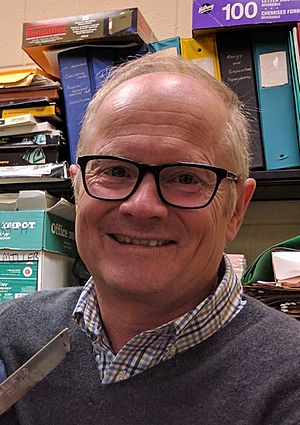R. J. Dwayne Miller facts for kids
Quick facts for kids
R. J. Dwayne Miller
|
|
|---|---|

R. J. Dwayne Miller in 2016
|
|
| Born |
Robert John Dwayne Miller
|
| Alma mater | |
| Known for |
|
| Awards |
|
| Scientific career | |
| Fields | |
| Institutions |
|
| Thesis | Electronic excited state transport and trapping in disordered systems (1983) |
| Doctoral advisor | Michael D. Fayer |
| Other academic advisors | Bryan R. Henry |
R. J. Dwayne Miller is a Canadian scientist and a professor at the University of Toronto. He studies how matter works at a very tiny level. His main work involves using super-fast lasers to watch atoms move.
His research helps us see what happens when chemicals react. It also helps us understand how living things work. He has developed new ways to study these tiny, fast movements.
Contents
Early Life & Schooling
Miller grew up in Winnipeg, Manitoba, Canada. In 1978, he earned a science degree in chemistry and immunology. He studied at the University of Manitoba.
He then went to Stanford University for his Ph.D. in chemistry. He finished this degree in 1983. His studies focused on how energy moves in systems like those used in photosynthesis.
What is Ultrafast Science?
Dr. Miller is famous for his work in "ultrafast science." This field uses extremely quick flashes of light, like super-fast cameras. These flashes are so short, they last only a few femtoseconds. A femtosecond is a millionth of a billionth of a second!
Using these fast flashes, scientists can take "pictures" of atoms and molecules. They can see how these tiny particles move and change during chemical reactions. It's like watching a super-slow-motion video of things that happen incredibly fast.
Seeing Atoms in Motion
One of Dr. Miller's big achievements is using "femtosecond electron diffraction." This method uses super-fast electrons instead of light. It helps scientists see how atoms move in real time.
Imagine trying to photograph a speeding bullet. It's hard to get a clear picture. Now imagine trying to photograph atoms that move even faster! Dr. Miller's tools make this possible. This helps us understand how materials work and how life processes happen.
Professor & Researcher
After finishing his Ph.D., Dr. Miller became a professor. He first taught at the University of Rochester in the United States. He also spent a year doing research in France.
In 1995, he moved back to Canada. He joined the University of Toronto as a professor. He continued his research there, studying chemistry and physics.
From 2010 to 2020, he also worked in Germany. He was a director at the Max Planck Institute in Hamburg. This institute focuses on the structure and dynamics of matter.
Dr. Miller is a member of several important science groups. These include the Royal Society and the Royal Society of Canada. Being a "fellow" of these groups is a high honor for scientists.
Sharing Science with Everyone
Beyond his research, Dr. Miller loves to share science. He wants more young people to get excited about it. He started and helps run an event called Science Rendezvous.
Science Rendezvous is a yearly festival. It lets the public, especially kids, explore science and technology. It's a fun way to learn about new discoveries and experiments.
Images for kids


